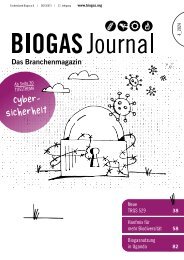You also want an ePaper? Increase the reach of your titles
YUMPU automatically turns print PDFs into web optimized ePapers that Google loves.
Municipal waste collection<br />
4 Municipal waste collection<br />
<strong>Biowaste</strong> collection from households and commercial activities are key <strong>to</strong><br />
providing feeds<strong>to</strong>ck for the biogas process. This chapter gives municipalities<br />
and stakeholders the basic elements <strong>to</strong> correctly structure separate<br />
collection schemes aimed at maximising capture rates of biowaste and<br />
minimising the impurities.<br />
In the EU, biowaste represents 39 % of all MSW, or<br />
approx. 175 kg per capita and year on average; these<br />
amounts include both food waste (or kitchen waste)<br />
originating from households, restaurants and other<br />
catering activities and biodegradable garden and park<br />
waste, such as leaves, grass, trimmings, etc. On a<br />
global perspective, and in lower income countries, biowaste<br />
ranges between 40 % and 65 % of MSW, thus,<br />
representing the main fraction <strong>to</strong> be managed, and also<br />
the main contribu<strong>to</strong>r <strong>to</strong> GHG emissions and leachate<br />
production at landfills. Waste that cannot be digested<br />
or that has a negative influence on the quality of the<br />
digestate disturbes the process. Hence, the separate<br />
collection of biowaste and its diversion from disposal <strong>to</strong><br />
recycling represents an obvious win-win situation that<br />
allows reduction of MSW disposal, <strong>to</strong> mitigate GHG<br />
emission and <strong>to</strong> produce renewable fuel (biogas in case<br />
of anaerobic digestion) and an organic fertilizer (digestate<br />
and/or compost).<br />
EU countries apply different approaches <strong>to</strong> collect biowaste<br />
separately and these divert a range of organic<br />
materials <strong>to</strong>wards recycling. For the purpose of producing<br />
biogas from biowaste by means of anaerobic<br />
digestion, collection schemes, which are able <strong>to</strong> limit<br />
the amounts of bulky, dry garden waste, are generally<br />
preferable, since the liquid and fatty content of food<br />
waste results in larger biogas production per <strong>to</strong>nne of<br />
fresh matter. Nevertheless, the choice of the specific<br />
collection scheme does depend on the final decision of<br />
local authorities and MSW companies.<br />
A first source of biowaste in cities is commercial activities<br />
of the hotel/restaurant/catering sec<strong>to</strong>r; separate<br />
collection is relatively easy and consists of equipping<br />
each user with one or more wheeled bins exclusively for<br />
biowaste and planning convenient frequencies for collection.<br />
This approach obtains relatively high amounts<br />
of biowaste at a limited number of so-called big producers.<br />
As an example, the City of Hamburg (Germany)<br />
collects about 22,600 <strong>to</strong>nnes of organic waste per year<br />
(t/a) from commercial activities, representing less than<br />
3 % of all MSW. But the largest producer-group of biowaste<br />
in a city or municipality is families. Hence, it<br />
is important <strong>to</strong> design the collection<br />
scheme so as <strong>to</strong> avoid any inconvenience<br />
and encourage households <strong>to</strong><br />
participate in source separation. The<br />
City of Milan (Italy) collected about<br />
103 kg per capita of food waste, including<br />
the amounts collected from<br />
the commercial sec<strong>to</strong>r, a <strong>to</strong>tal of<br />
140,000 t/a.<br />
Separate collection of foodwaste in Milan<br />
The first step and challenge for local<br />
authorities organising biowaste collection<br />
from households is <strong>to</strong> make the<br />
separation task easy at home. Schemes<br />
aiming <strong>to</strong> collect significant amounts of<br />
food waste from households use collection<br />
<strong>to</strong>ols that are tailor-made <strong>to</strong> needs<br />
in order <strong>to</strong> intercept highly moist and<br />
digestible putrescible waste. Nowadays<br />
the standard <strong>to</strong>ols are kitchen<br />
baskets (6 – 12 litre) <strong>to</strong> be used with<br />
watertight bags. The small size of the<br />
basket s<strong>to</strong>ps households delivering<br />
bulk impurities (e.g. bottles, cans),<br />
while vented kitchen baskets additionally<br />
reduce the production of leachate<br />
12

















